Click on the heading above to view the full article. (Download your copy.) Recorder website: https://volksrust.net/the-recorder/

Scan the QR Code below for quick access instead of typing the URL/Internet address. The QR code below can also be downloaded and shared (via Whatsapp) for this ONLINE edition of the Recorder.
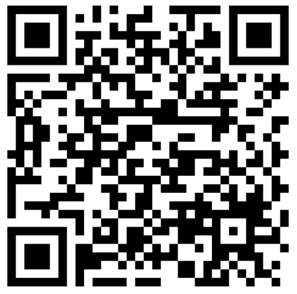
The free QR Code Scanner app can be downloaded from: https://play.google.com/store/apps/details?id=com.teacapps.barcodescanner (The link opens in a new tab.)
In this edition / In hierdie uitgawe……
(Click on any of the blue link news headlines below to be taken to the news article of your choice / Kliek op enige van die blou skakel nuusopskrifte hieronder om na die nuusartikel van jou keuse geneem te word)
Do you have any loved one like a relative or friend who has passed away, and you would like to post your funeral notices or obituaries? Contact us. We will do it for you for free and at absolutely no cost to you. Contact Carlos Pereira on his WhatsApp at 067 271 0270 or email us at admin@volksrust.net. Our previous email at recordervolksrust@gmail.com is no longer in use so kindly refrain from emailing us to that email. The only email now in use is: admin@volksrust.net
If any advert(s) have been submitted to us (and paid for) but it has not appeared in this edition of the Recorder, do contact us as soon as possible so that we can either reimburse you or alternatively include it in our next October 1st edition 2023. Our contact details can be found directly right at the top of this page and it appears in our Recorder logo. Thank you.
School News / Skool Nuus
NDA Workshop.
Volkies speel tennisrondomtalie – 15 Augustus.
Akademiese Uitslae op 16 Augustus.
Our Choir Shines Yet Again.
VHS Landloop Interhoër 2023.
Newcastle Eisteddfod for English.
Akademiese Uitslae vir Volkies.
News / Nuus
TRUCKERS – THE BACKBONE OF LOGISTICS IN SOUTH AFRICA.
Where Are You on The Road to Water Digitisation?
Newsflash: High School Entrepreneurial Scholarship Opportunity Closing!
Obituary: Philile Mkhwanazi.
Workplace empowerment: Why mentorship matters.
Rural roots grow powerful trees! How three young Mpumalanga women are making their mark on the tourism economy.
Polio Awareness!
Be proactive about your breast health this Women’s Month.
If you’re not advertising online, you’re invisible.
Making the ‘Rite Cut’ – A safer path to adulthood.
When it’s more than just winter blues…
Nedbank offers young professionals 5 useful tips for buying their first car.
Neuroscientist Reveals The Shocking Science & Benefits of Taking a Simple Walk | Mel Robbins Podcast.
INVITATION FOR PUBLIC COMMENTS IN APPLICATION FOR A LIQUOR LICENCE: NXUMALO, NDUMISO PRINCE VUKILE
Recipe of the month: Quick Breakfast Muffin Quiche Recipe.
If AI has a dark side, it’s us.
Survey shows SA consumers are still confused about the impact of paper on forests.
INNOVATIVE FINANCIAL ASSISTANCE SCHEME LAUNCHED TO FUND COMMUTING COSTS FOR IMPOVERISHED STUDENTS.
Crocheted parrots help women to support their families whilst saving endangered birds.
Volksrust Local Security Firm Recovers Stolen Electrical Cables.
Recorder Classifieds / Rekorder Geklassifiseerd
See advert(s) below.
School News / Skool Nuus
NDA Workshop
When: 22/04/2023
Where: Vryheid
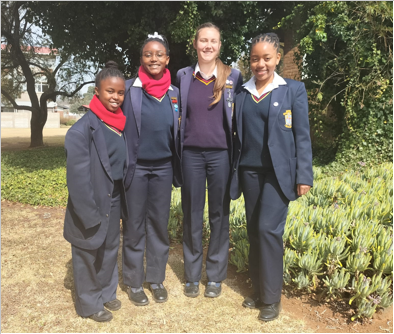
Background: A contemporary and Hip-Hop workshop presented by the National Dance Association. The presenters were South African dancers who participated internationally. Learners from various dance schools participated in the workshop. The dancer’s abilities were challenged and they were presented with new ideas at the same time.
The following learners participated:
· Asanda Sishange
· Zimi Thwala
· Minenhle Sibiya
· Sbongakonke Masondo
· Okuhle Mzibuko
· Nerissa van Heerden
*****************************
Volkies speel tennisrondomtalie – 15 Augustus.
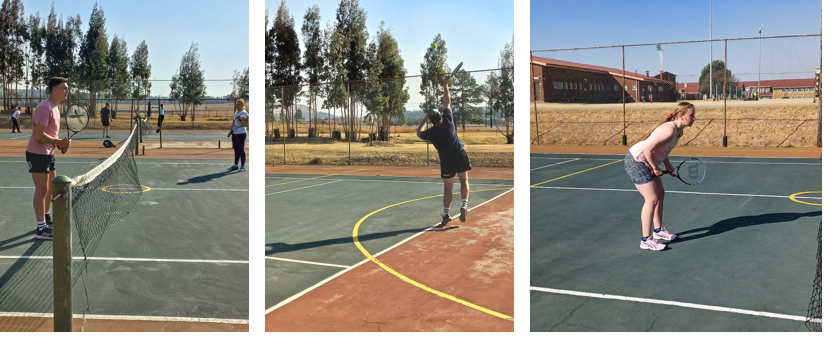
Die tennisbane was vir ‘n slag weer “tjok en blok” vol, toe die leerlinge en onderwysers mekaar op die tennisbaan aangevat het.
Dit was so lekker om die tennisballe te hoor klap en sommer net saam te ontspan. Tennis is ‘n fantastiese sport en ons het dit net weer in hierdie amper-lentetyd ervaar. Hopelik gaan sosiale tennis vir die res van die jaar, hier by Volkies floreer.
Thank you so much in partaking in this wonderful event, some for the first time. We are definitely going to do this again!
Congratulations to Divan & Marika, Tiaan & Hayley and Martin & Diaan, Leah & Chantel who must take each other om, in the finals!
~me. Hannetjie Taljaard~
*****************************
Akademiese Uitslae op 16 Augustus.
Graad 12
Rekeningkunde
Sekwanele Maseko 94,
Prince Kusi 94,
Lindiwe Mbatha 90,
Juwairiya Moola 86,
Duwan van Niekerk 86,
Avumile Dlangalala 84,
Azokuhle Masondo 82,
Colin Clarke 82,
Kelvin Vilakazi 80,
Malwande Ntuli 80,
Siyanda Masina 80
*****************************
Our Choir Shines Yet Again.

Our Volkies Choir made us proud once again at the Newcastle High School Choir Festival on the 24th of August. Singing in Italian, Scottish English and IsiZulu, our choir had the audience clamoring with excitement. We would like to congratulate our Music Director Mrs Steyn, Vocal Coach Mrs Dladla and all our Volkies choristers for using music to bring joy to many! With this, the Volkies choir closes its choir season for 2023 on a high note.
*****************************
VHS Landloop Interhoër 2023

Die landloopatlete het Woensdag deelgeneem aan die Interhoër by Morgenzon Landbouskool.
Saphira van Aswegen wen ‘n silver medalje in die 4 km junior meisies en het uithouvermoë getoon toe sy aan die einde spoed gee en die Secunda meisie verbysteek.
Olwethu Mathabathe het ‘n asemrowende wedloop gehardloop toe hy loshande Interhoër vir junior seuns met 56 atlete wen!
Kamva Matiwane het uitstekende verbetering getoon en 3de in die 6 km senior geëindig.
Spanne:
Ons Junior seuns is aangekondig as die Liga wenners, en verwerf almal goue medaljes en die trofee. Verder het die span almal silver medajes op Interhoër gewen: (Met slegs 1 punt teen Standerton verloor)
Junior Seuns span: Olwethu Mathabathe, Katheho Malefetsane, Bayanda Nsukazi, Nklakhanipho Gwebu, Nklakhanipho Nlangamandla, Keegan Jacobs en Imraan Badat.
VHS Senior seuns het derde in die liga geëindig en almal brons medaljes verwerf in die liga.
Senior Seuns span: Kamva Matiwane, Francois de Jager, Mphilonhle Bhembe, Andile Shabalala, Vuyani Khumalo en Siyabonga Mavuso.
Ons junior meisies het in die liga vierde geëindig. Hulle het ware Volkie guts getoon, waar twee van ons meisies (Kaylee en Amelia) met weke lange beserings die wedloop aangepak het en uitstekend presteer het.
Junior Meisies span: Saphira van Aswegen, Sbongakonke Masondo, Kaylee Schlebush, Amelia Pretorius en Meryke van Niekerk.
Hierdie atlete het maande lank getrou geoefen en werklik altyd met positiewe gesindhede opgedaag en nooit moed verloor nie (nie eers in die vakansie). Min besef dat ‘n 4 km en 6 km nie vanself kom nie, maar bitter harde werk en baie uithouvermoë verg.
VHS is ongelooflik trots op hierdie atlete.
Ons sien uit na die Mpumalanga proewe die 9de September 2023.
~me. Ané Hamman~
*****************************
Newcastle Eisteddfod for English.
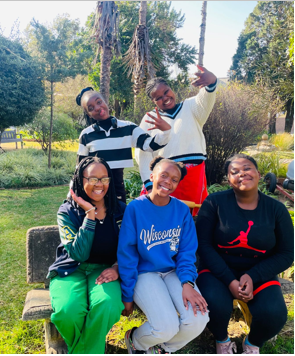
“You may trod me in the very dirt, but still, like dust, I’ll rise.” These are the words of the famous poet Maya Angelou that describes the journey that our gold medalists endured. A group of dedicated young learners who were always eager to practice, they sacrificed their break times and at times stayed just a little bit longer every day after school to perfect their craft. With so much devotion they were motivated to give nothing but the best and that is surely what they did. We are proud to announce that on the 21st of August 2023 Volksrust High School walked away from the Newcastle Eisteddfod for English with 3 gold certificates, 1 double and 1 triple gold certificate.
*****************************
Akademiese Uitslae vir Volkies.

Graad 12
Afrikaans Huistaal Letterkunde
Meliné Delport 100, Chantel Delport 93, Luané Martins 81
Besigheidstudies
Lindiwe Mbatha 87, Azukuhle Masondo 85
Graad 11
Rekeningkunde Gevallestudie
Huzayfa Dadabhay 94, Nkosinathi Ngwenya 94, Anoushke Houy 92, Keneilwe Moloi 92, Mohammad Sema 92, Nasiha Moola 90, Onge Madi 88, Nothando Mbatha 88, Tlotlego Matlou 80
Wiskunde
Francois de Jager 98, Anoushke Houy 94, Dawid Groenewald 88, Lungelo Mngadi 82, Phembu Msimango 80, Zimkhona Thwala 80
Wiskundige Geletterdheid
Nino Lombard 92, Keneilwe Moloi 90, Michelle Olivier 88, Stephanie Coetzee 88, Danelle van der Watt 86, Danielle Venter 82, Danica Venter 80, Sabelo Nsibanyoni 80, Angelique van Wyk 80, Matthew MacDonald 80, Carli Cromhout 80
Graad 10
Wiskunde Opdrag
Jonathan Koekemoer 94, Nardos Mesfin 86, Kaitlyn van der Merwe 80
Wiskundige Geletterdheid
Siphosothando Sangweni 96, Zoë Biggars 94, Andre van der Walt 92, Sineliso Magubane 92, Jessica Delport 92, Abrie Cilliers 92, Bernique Janse van Rensburg 90, Owethu Sibuja 90, Philasande Nkosi 90, Vernon Lombard 88, Nomfundo Mgcina 88, Muhammed Hanslod 86, Thato Pitjeng 84, Ayabonga Shabalala 84, Sean Hens 84, Marco de Bruyn 82, Siphosethu Lukhele 82, Thabang Mphore 82, Chanel Knoetze 80, Bonga Sithole 80
Graad 9
Wiskunde Projek
Danél de Jager 100, Muhammad Moola 100, Nila Deacon 98, Rayhaan Moola 98, Sinenhlanhla Nombewu 98, Aphenhle Msibi 96, Thandolwethu Ngomane 96, Lebogang Nkwane 96, Nico Nel 94, Minenhle Nsibande 92, Lusanda Dhlamini 92, Banele Coka 90, Rearabetswe Moloi 90, Nokuhle Mntambo 90, Nolwazi Thabethe 90, Nhlakanipho Gwebu 88, Sandiswa Ngwane 88, Thandolwethu Bhekiswayo 86, Khwezi Thwala 86, Azile Hlatshwayo 84, Londiwe Kunene 84, Shakaza Luhlanga 84, Leanné Moll 82, Sbonga Masongo 82, Husnaa Parak 82, Jolien Kraft 80, Nhlakanipho Masango 80
Graad 8
Wiskunde Projek
Rofhiwa Mawela 96, Amahle Manyathi 94, Shaun Delport 94, Mckayla Smit 94, Zaid Chothia 92, Mpilonhle Zwane 90, Zahnia Delport 90, Yoridanos Manito 88, Mia Cronje 88, Marlize van der Merwe 88, Zyanda Buthelezi 86, Ayesha Badat 84, Mathemba Makhubu 84, Tanatswa Ngirande 84, Nomadlozi Ngwenya 84, Sibusis Shabalala 84, Immelda Mohube 82, Ncedolwethu Ntembe 82, Siphosethu Jele 80, Xolelwa Khumalo 80, Ziyanda Maboea 80
*****************************
News / Nuus
TRUCKERS – THE BACKBONE OF LOGISTICS IN SOUTH AFRICA.

Negative publicity abounds around truckers, their impact on our roads, driving habits and so much more. Dig a little deeper and you will find that there is far more to it than what our initial perceptions may lead us to believe.
Owing to the fact that the major industrial and consumer output of South Africa is land locked, located in the interior of the country, our economy is reliant on efficient transport systems for both import and export. The rail network has struggled to compete with truckers, who deliver door to door, thus reducing double handling, reducing risk, and vastly improving delivery times, making truck transport the preferred option.
The costs of fuel, repair and maintenance, and insurance are constantly rising and squeezing margins in the road freight industry. Drivers have a major influence on all these factors and can safeguard the sustainability of the business through safe and efficient driving.
“To recognise the expertise and awareness of effective truck drivers, we launched the #ThankYouTrucker campaign in conjunction with the Road Freight Association (RFA), three years ago,” says Elvis Mutseura, Product Marketing Manager of Iveco, “ the objective of which is to pay tribute to the Truckers who keep the logistics industry moving, to raise awareness about the important contribution that the drivers make and to provide motivation for those that are entering into their trucking journey.”
Truck drivers carry a great deal of responsibility, not just in ensuring that the deliveries remain profitable and are delivered timeously, but also in terms of road safety.
“Any incentive that leads to responsible behaviour in trucker performance will have many unseen consumer benefits,” adds Gavin Kelly, CEO of the RFA.
The #ThankyouTrucker campaign is looking for the most extraordinary freight driver, a remarkable
individual who goes above and beyond the call of duty. Some of the criteria used to judge the drivers, include their helpfulness, trustworthiness, dependability, safety records as well as the care and passion that he or she display towards their chosen career.
Drivers are nominated by company owners, operations managers, direct line managers or fleet managers and only South African drivers in the road freight industry in South Africa can be nominated. The nomination period is open till 2 September 2023, voting is open to anyone, but limited to one vote per person/device. The driver who receives the most votes wins and the winner will be announced on www.thankyoutrucker.co.za on 9 October 2023.
In addition to recognition that comes from winning the competition, the overall winner will receive a R50 000 cash prize. The first runner-up receives R10 000 and the second runner-up R5 000.
For further information visit thankyoutrucker.co.za.
*****************************
Where Are You on The Road to Water Digitisation?
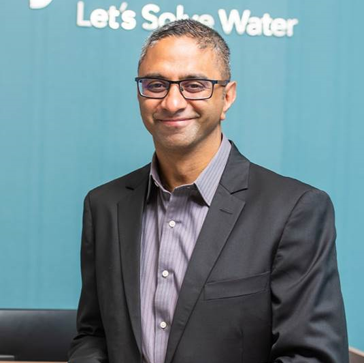
Understand the five stages of water digitisation maturity and how they impact water management and revenue.
Johannesburg, 23 August 2023: Municipalities are looking for opportunities to improve service delivery and cash flow. Yet many still don’t realise the hidden gains of digitising their water systems.
On average, local towns and cities lose nearly half their water income (a phenomenon called non-revenue water). According to the Department of Water and Sanitation, most local regions lose between 30 and 50 percent of water revenues. Non-revenue water costs our economy R7.2 billion annually due to water losses. This drain is primarily from municipal pockets; for example, eThekwini Municipality’s 50 percent non-revenue water losses amount to R700 million annually.
That’s money left on the table. The value of chasing that money is substantially better and easier than increasing taxation and rates. Investing in water infrastructure builds a municipality’s financial and service future. And it is within reach through water digitisation.
Water digitisation can occur without removing current systems and infrastructure. It represents a range of benefits: cost-savings, automation, greater efficiencies, and data-driven strategic planning. Whether to improve wastewater, manage pipe infrastructure, enhance billing capture and delivery, or reduce pollution, municipalities can achieve great things quickly with digitisation.
Every municipality should consider digitising their water systems. But where do they start? The first step is to know where they currently are. A landmark paper by the International Water Federation and Xylem explores this question and identifies a maturity spectrum for water digitisation.
The digital maturity of water operations runs through five categories:
● Not started: These are sites with only legacy analogue infrastructure. There are no digital strategies or technologies in play.
● Basic: Basic sites have begun incorporating digital technologies into their operations. They are developing online monitoring capabilities by combining Supervisory Control and Data Acquisition (SCADA) and Internet of Things (IoT) systems.
● Opportunistic: Sites qualify as opportunistic; they start redesigning their operations with digital automation and control enhancements. A clear sign is the presence of analytics tools utilised for process optimisation.
● Systematic: In systematic sites, digital technologies are well established. There is evident inter-process automation and control, and the site’s internal resources and platforms work with digital infrastructure.
● Transformational: In the most mature stage, transformation sites incorporate digital technologies across business and operations processes, using advanced analytics for decision-making.
Many water-management systems in SA still fall in the first two categories, with some moving up the stack. But this is not a race. It’s not imperative that water sites all graduate to ‘transformational’. Every digital addition to a site will deliver benefits in costs and performance. A ‘basic’ site will produce considerably more benefits than one still at the starting line. Every step forward leads to outsized results.
How can municipalities move the dial forward? The IWA and Xylem report offers some advice:
● Not started: Acknowledge digitisation as a business priority and develop a digital strategy. Pursue pilot projects to explore digital implementation.
● Basic: Mobilise pilot projects and learn from industry peers and research. Inform customers and employees of the new direction, and look at how to transition recording, billing, and similar processes from paper to digital.
● Opportunistic: Enhance and stabilise data infrastructure and align operations around data-driven goals. These steps will lay the pipes for incorporating next-level technologies.
● Systematic: Use new digital technologies to develop new products and services through digital technology. Develop an evolving digital framework and align projects with the new digitally-powered business strategy.
● Transformational: The work is not done! Continue using digital technologies to implement increased efficiencies. Exchange best practices with other utilities and study the breakthroughs in the modern water industry.
Municipalities can increase revenue and service delivery, often through a few straightforward deployments of digital services. They can analyse their current stockpiles of data, add digital dashboards and alerts for site personnel, inspect pipes and other infrastructure cheaply and without service disruption, activate smart billing, reduce pump energy and maintenance, and much more.
Xylem has been helping towns and cities across the globe to revitalise and digitise their water sites. From the Cape to Cairo, we work with African municipalities to solve their water challenges and gain long-term value and revenue. As your trusted water solutions partner, we can provide the insight, skills and services to complement your strategies and workforce.
Where do your water sites stand on the road to water digitisation, and how can Xylem help you reach your destination? Start your journey today and discover how digitisation boosts your community’s solvency, prosperity and service-delivery excellence.
*****************************
Newsflash: High School Entrepreneurial Scholarship Opportunity Closing!
Newsflash: Unlock Your Entrepreneurial Potential. High School Entrepreneurial Scholarship Opportunity Closing!
APPLICATIONS CLOSE ON 15 SEPTEMBER 2023
23 August 2023: Applications for the Allan Gray Orbis Foundation’s entrepreneurial opportunity, also known as the High School Scholarship opportunity, closes on 15 September 2023. Grade 6 learners across the country are invited to apply for this life-changing opportunity to be part of a community of young leaders who will create value as part of their entrepreneurial careers.
The Programme offers Grade 6 learners with the best entrepreneurial opportunity to build the life they want for themselves through quality education at one of South Africa’s top achieving partner High Schools.
Applicant Criteria:
Applicant must be in Grade 6 this year (2023) to apply.
The Scholarship opportunity is an entrepreneurial programme in addition to financial support for High School.
Applicant must show interest in becoming an entrepreneur or business owner.
Applicant cannot be older than 12 years of age and not younger than 11 years of age in Grade 6 (2023).
Clearly demonstrate financial need (Household income must not exceed a monthly gross income of R20 000, including business revenue).
Applicant must obtain a minimum of 70% for English and Mathematics in Grade 5 (December report) and 6 (June report).
Applicant must obtain a minimum overall average of 70% average for all subjects in Grade 5 (December report) and 6 (June report).
Applicant must be a South African citizen (One parent must be a South African citizen)
Ways to Apply:
Visit www.allangrayorbis.org to apply online or download the application forms.
Post application form to Allan Gray Orbis Foundation, Freepost no: CB 11349 Kloof Street, 8008. Register your mail so you can track it to avoid the application form from being lost.
Hand Deliver to 46 Hof Street, Oranjezicht Cape Town or 1st Floor, Cliffe Dekker Hofmeyr, 1 Protea Place, Cnr of Fredman Dr and Protea Place, Sandton, Johannesburg.
More information is available at www.allangrayorbis.org and www.facebook.com/allangrayorbis.
*****************************
Obituary: Philile Mkhwanazi
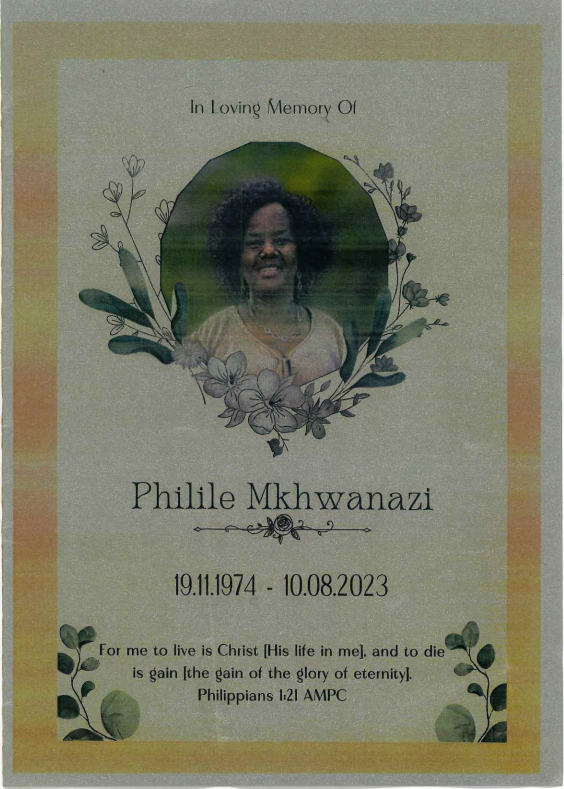
*****************************
Workplace empowerment: Why mentorship matters.
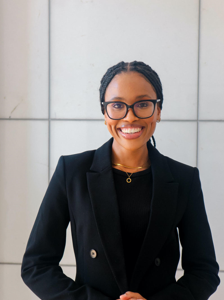
In workplace empowerment, mentorship matters — one woman’s story shows us why
Much is made of the importance of female mentors in the workplace — and with good reason. At every stage of their education and professional development, girls, graduates and young women should be able to look up to and be supported by leaders who understand their circumstances and challenges. Female mentorship helps to build social capital, nurture ambition, and break down barriers to advancement.
But male mentors also have a role to play. In fact, given their often established and usually unquestioned positions of authority, the responsibility they carry is arguably greater.
They’re often able to influence workplace culture with relative ease, and so stand to facilitate gender-inclusive ways of thinking and working. By mentoring and supporting young women — and encouraging others to do the same through gender-aware workplace training and education — they stand to make long-term gains in terms of female empowerment.
In her working life, Phemelo Segoe, the Brand and Marketing Manager at Optimi Workplace, South Africa’s leading skills development, education and training provider, has experienced this first-hand.
Segoe has worked in education since the very beginning of her career. After completing her brand building and management degree at Vega, she started her first job at an organisation that made school bags for children in rural communities out of recycled plastic and fitted them with solar panels. The solar panels would charge while the children walked to and from school, so that they could be used for light at night.
The role taught her a lot about the intersection between education and corporate sponsorship: why sponsorship programmes that operate in this space fail, and what needs to be in place to ensure they succeed. She carried these lessons into her next position at Tuta-Me, which later became part of the Optimi Group.
“When I joined Tuta-Me, it was still a start-up trying to connect learners to tutors. It hadn’t yet evolved to the comprehensive bursary model that exists today, where corporates sponsor tutoring sessions for the learners and students who form part of their bursary programmes. At the time, the team comprised me and four others — all men.”
This experience would have a huge impact on Segoe.
“As a young black woman working primarily with men, I was constantly struck by how confident they were. If one of my colleagues thought of something, we did it — we put it to the test. It showed me how differently men operate in the workplace compared to women. Men, I’ve found, are encouraged to try, even if they fail. Women, however, are expected to be smart and cautious. We’re told not to stick our heads out too much, especially if what we’re attempting might not work.”
Segoe’s colleagues were serial entrepreneurs who had learnt the value of learning from mistakes, exploring alternative options, and pushing boundaries. As a member of this team, she was encouraged to do the same — to fail forward, to put herself and her ideas to the test, to raise her hand.
“It’s a missed opportunity to think that young girls should only be partnered with female mentors,” she explains. “Young women have a lot to learn from male leaders. I learnt a lot from what my colleagues said, but especially from how they behaved. They taught me that the fear I battled was in my head, and that I was often my greatest stumbling block.”
Of course, not everyone has this experience, and Segoe is aware that her anecdotal evidence doesn’t make it a workplace standard. Women don’t always find the psychological safety they need to take calculated risks, be bold, and succeed in their careers.
But this is where the responsibility of male leaders comes in. They have an opportunity to create environments where young women feel safe and supported, and are equipped with the skills they need to become leaders themselves. “This doesn’t rest on the shoulders of women who have already become leaders — at least not exclusively — but also on men who are still building up the gender diversity all businesses need to succeed,” Segoe adds.
In this context, workplace education is everything. It informs teams about the benefits of having gender diverse work in terms of productivity, collaboration, fairness and the bottom line, and helps to put effective mentorship programmes in place. “Companies need to dismantle their own restrictive ideas about the role of women in the workplace, and whose responsibility it is to mentor them,” says Segoe. “Workplace training can help here.”
It starts with planting the seed: gender parity in the workplace is everyone’s responsibility, men included. From there, if properly executed, sustainable change and long-term success is possible.
*****************************
Rural roots grow powerful trees! How three young Mpumalanga women are making their mark on the tourism economy.
Young women are seizing the initiative and making strides in Mpumalanga’s tourism and hospitality industry, and one has even discovered an entrepreneurial streak – defying the odds stacked against them in an area where youth unemployment soars as high as 65%.
Thanks to hard work, determination and sheer grit, Lwazi Thobela, Vutivi Mthimkhulu and Mampho Makofane have shrugged off the more difficult circumstances that often come with living in rural villages to become active participants in the burgeoning wildlife economy in and around the Kruger National Park.
The luxury and comfort of the Kruger Shalati private lodge – which straddles the Sabie River in Skukuza and offers converted train carriage accommodation on its distinctive Train on the Bridge – is a far cry from the humble streets of Mkhuhlu, 40km away, where some of these young women hail from.
Yet it is one of the many private lodges dotted around the Kruger National Park that are investing in local communities by employing work-ready graduates such as these. They are in strong demand thanks to the Good Work Foundation (GWF), an education non-profit operating five digital learning campuses in the Hazyview and Bushbuckridge area.
Young mum triumphs against the odds
With dreams of becoming a chef, Lwazi Thobela’s plans were put on hold when she fell pregnant in her teens – but now, with the support of her GWF family, she has found a balance between being a caring mother and pursuing her ambitions.
After motherhood came knocking, Lwazi resolved to resume her education journey by enrolling in GWF’s Bridging Year Academy, gaining digital and work-readiness skills to have a fighting chance at getting a job in rural Mpumalanga. She then studied hospitality at the foundation’s Travel & Tourism Academy – but fate again threw obstacles in her path.
“Previously, I’d had the opportunity to do chef training in Graaff-Reinet but had to decline because of family commitments. Then, when I was offered a position at Hippo Hollow Country Estate [in Hazyview], my child was sick and I couldn’t take up the position. But the Good Work Foundation kept in touch with me, constantly checking in to ask me how I’m faring, do I need assistance finding work, and so on.
“When the opportunity to do an internship at Kruger Shalati came up, Madam Tarshine [Mafuyeka, the GWF Hospitality Academy coordinator] phoned me to ask if I’m interested – and here I am! I’m hoping the internship [via the Youth Employment Service] will become permanent in time.”
Lwazi counts “being patient, being humble and working hard” among the personality attributes that have got her this far – that, plus the support of her GWF mentors who kept urging her to chase her dreams.
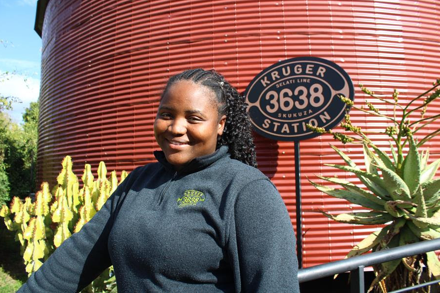
The bar lady who doubles up as a taxi owner
Another example of empowerment in action is Vutivi Mthimkhulu, who tends the bar at Kruger Shalati. After completing her BYA post-school training to become more digitally literate, she enrolled in a short course in hospitality management – with GWF assisting her with the practical component.
This helped her secure a job at Shalati in 2020. Says Vutivi, “I was nervous at first, but luckily I had learned how to use a computer at the Good Work Foundation, so I wasn’t starting out with a blank slate. I began as a cashier then I moved on to be a barista – and now I am working as a bar lady.”
But she is taking self-empowerment a step further – thanks to her job, she saved up and bought a Toyota Avanza, and is now the proud owner of a taxi.
“I can now firmly say that I am a businesswoman. My mom was so proud of me when I bought the taxi. She said to me, ‘This is why I named you Vutivi – your name means ‘knowledge’ [in Xitsonga], and you have shown that you really are knowledgeable.’”
This young entrepreneur says her GWF certificate has opened many doors. “I love it here; there are so many opportunities and avenues for growth. I am now a permanent member of the Shalati staff. I can feed myself and my family – and it’s all thanks to GWF.”
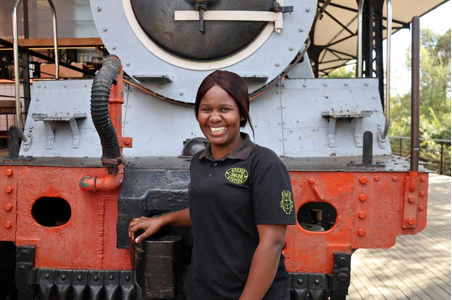
The dignity of being a breadwinner
Mampho Makofane is a cashier at the Kruger Station restaurant, run by Kruger Shalati. She has been working there since it opened two years ago, having studied at GWF’s IT Academy and then at its Travel & Tourism Academy.
Mampho says the practicals at different hotels and restaurants gave her valuable experience to help her land her current job. “I was so happy when I got my first pay cheque,” she remembers. “My family are very proud of me being a breadwinner.”
She says she loves working at Kruger Shalati, alongside a group of young people who also studied at GWF: “The other GWF staff here are my friends and family.”
Her advice to other young women is to “keep on pushing, keep on pulling your socks up, because one day you will get a job. GWF has improved my life; I never thought I’d be here, working at Kruger Shalati!”
Where does Mampho see herself in the future? “I see myself being a manager. I want to see myself growing here.”

Training and placing young people in jobs
Vincent Mlambo, human resources manager at Kruger Shalati, says there are currently eight GWF graduates working at the lodge. “They come to us fresh from graduating, and they know their theory and how to follow the necessary steps. It’s easy to teach and guide them, as they are applying the knowledge they have.
“GWF graduates always impress us with their knowledge during interviews, and most receive Employee of the Month awards, nominated by fellow staff members – some more than once! We find they are great team players and can assist us across departments.”
Kruger Shalati is but one of the many lodges where GWF graduates are making their mark, and Lwazi, Vutivi and Mampho are just three of the many success stories of GWF’s pioneering Ecosystem of Learning and Working.
For a nominal “commitment” fee, young school-leavers at its Bridging Year Academy and career academies learn essential digital and work-readiness skills. Then, GWF uses its relationships with lodges and other partners to get these graduates placed – a win-win situation, because the establishments know they are hiring quality employees.
This effectively helps Mpumalanga to “grow its own timber” by producing job-ready graduates – all fired up and ready to assume the mantle of family breadwinner with pride.
Issued by Flow Communications on behalf of Good Work Foundation. For more information or to arrange an interview, please contact Khaya Thwala on khayat@flowsa.com or 078 349 0668.
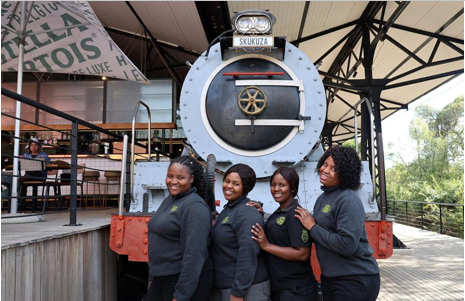
*****************************
Polio Awareness!
(Author: Sr Sphiwokuhle H. Mkhonza , Amajuba Memorial Hospital)
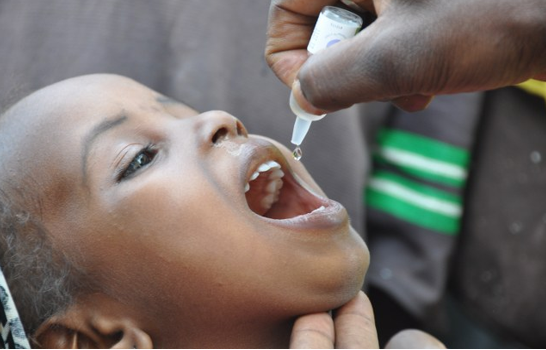
Polio Awareness Week is a time to reflect on and raise awareness about this devastating disease and the importance of immunization. However, it is more than that. It is a call to action – a time to do our part in helping eradicate polio, once and for all.
Poliomyelitis (polio) is a highly contagious viral disease that can cause paralysis and sometimes even death. It is most common in children under 5 years of age, but anyone can contract the disease. The virus is transmitted from person to person and
is mainly spread through the fecal-oral (from the feces to the mouth) route or, less frequently, through contaminated water or food. Once spread, it multiplies in the intestine, takes control of the nervous system, and causes paralysis.
Symptoms
Polio symptoms usually last for 2–10 days, and recovery is complete in almost all cases. Polio symptoms include:
• Fever
• Fatigue
• Headache
• Nausea and vomiting
• Stiffness in the neck
• Pain in the limbs
90% of the time, polio does not cause any symptoms. But in an unlucky 10% of cases, the virus can cause paralysis. Paralysis can happen as quickly as within a few hours of infection. In the most severe cases, it can lead to death. This is because the virus can also affect the muscles that control breathing, and if the breathing muscles become paralyzed, the child will suffocate and die.
Prevention
Polio is a preventable disease. There is no cure for polio, but it can be prevented through vaccination. South Africa provides routine vaccination for poliovirus. The current vaccination schedule in the Expanded Programme on Immunisation (EPI-SA) consists of two doses of bivalent oral polio vaccine (bOPV) at birth and 6 weeks of age, followed by the trivalent inactivated polio vaccine (tlPV) included in the hexavalent vaccine at 6, 10, and 14 weeks of age, and finally, a booster dose of tlPV is given at 18 months of age. The polio vaccine is safe and effective and can protect a person for life.
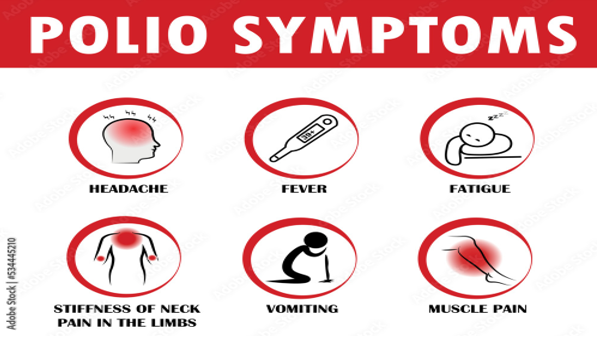
Treatment
Treatments for polio focus on limiting and alleviating symptoms. Heat and physical therapy can be used to stimulate the muscles, while antispasmodic drugs are used to relax the affected muscles. Although this can improve mobility, it cannot reverse permanent polio paralysis.
In the next 10 years, there could be as many as 10 000 new cases of polio worldwide if the last remaining areas where it still exists are not eradicated.
This is why it is critical to ensure that polio is eradicated completely. By raising awareness about polio, we can ensure that everyone gets access to the vaccine and that the illness is eventually eradicated. The prevention of polio outbreaks, the protection of children, and the support of polio eradication all depend on raising knowledge of the disease.
Eradicating polio is a goal that is within reach, but it will only be possible if we all work together.
NB all children 15 years and below presenting with acute paralysis of the lower limbs must be taken to the healthcare facilities for further investigation.
*****************************
Be proactive about your breast health this Women’s Month.
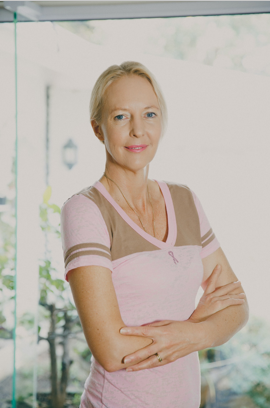
Thursday 10 August 2023, This Women’s Month, internationally acclaimed specialist surgeon and breast health specialist Professor Carol-Ann Benn addresses some of the uncertainties and misperceptions that may hold people back from breast cancer screening and provides practical advice on the questions to ask before treatment.
“Most people who get breast cancer don’t have risk factors, so they think it can’t happen to them. Breast cancer is unfortunately one of the most prevalent cancers among women, affecting approximately one in 27 women over the age of 15 years,” says Prof Benn, founder of the Netcare Milpark Breast Care Centre of Excellence.
“Although a family history of cancer, on either biological parent’s side of the family, can contribute to higher individual risk, young people do not fit into the usual screening age group, where mammograms are recommended for women over 40. Younger women who have breast cancer usually present with a symptom such as a mass in the breast, nipple discharge, or enlarged lymph nodes.
“Symptoms such as these should always be investigated, preferably by ultrasound scan. Do not simply wait until your next monthly cycle or hope that it will resolve itself ¬– being proactive about your breast health at any age is crucial. Although survival rates are improving all the time, early detection can make a great difference to the treatment journey and prognosis.”
Professor Benn urges anyone who detects a breast lump to seek second opinions and investigate all options, especially if appropriate radiology imaging has not been performed yet. “If a doctor does a physical examination only and or tells you that you are too young to have cancer, ask for an ultrasound because no doctor has eyes on their fingers that can rule out breast cancer,” she says.
“If there is a mass, or if you are told it is a fibroadenoma, have a three-month follow-up as the minimum after your first ultrasound, as this can tell the difference between a fibroadenoma and breast cancer. If the lump grows, insist on a core needle biopsy.”
Professor Benn encourages people with a lump or suspected breast cancer to resist being pressured into making a snap decision about their treatment. “Remember, it is your body – don’t let a surgeon cut something out without knowing what it is. Under no circumstances should you agree to have surgery to ‘find out if this is cancer’.”
Prof Benn’s acronym ‘SMS’ offers practical advice if confronted with a breast cancer diagnosis:
S for Safety: do not be rushed into treatment, either surgery or chemotherapy.
M for Multidisciplinary: a multidisciplinary team must first provide you with all the options open to you, and
S for Second opinion: Seek a second opinion, listen, take notes and ask questions. Take the time to consider all the options before proceeding with treatment.
The Netcare Milpark Breast Care Centre of Excellence offers rapid access to best practice care without the person being rushed into treatment. A complete and robust multi-disciplinary review of the patient is conducted within seven days, and our process is geared towards carefully selecting the best treatment options for cancer care, taking each patient and their circumstances into consideration holistically.
Under Prof Benn’s leadership, the centre was the first breast care centre of excellence to be internationally accredited in South Africa and was invited by the American College of Surgeons’ National Accreditation Program for Breast Centers (NAPBC) to contribute its protocols for the development of international best practice guidelines.
“Breast cancer treatment has progressed significantly and the vast majority of breast health conditions do not require surgery these days. Radical mastectomies, where the entire breast and nipple are removed, are no longer used. Cancer does not ‘jump’ from one breast to the other, so if you are advised to have a double mastectomy, this should always be questioned and interrogated by a multidisciplinary team. If surgery is needed, usually women have a choice in the different types of cancer surgery.”
“Women diagnosed with breast cancer should also be informed and ask questions about the implications of their treatment options for fertility before starting any treatment. “Discussions should include conception, timing of pregnancy after treatment, the safety of pregnancy and whether breastfeeding will be affected.”
“It is emotionally challenging to face a cancer diagnosis and people often feel anger, depression, anxiety, a sense of helplessness or vulnerability and feel the unfairness of the situation. The most difficult period is often between diagnosis and treatment, but knowing more about the treatment and realistic expectations of the course of management and the future will help,” she says.
The Netcare Milpark Breast Care Centre of Excellence in Johannesburg is among the top accredited centres of its kind in the world and has always strived to provide the best standard of care both to patients with access to medical funding and those without medical insurance.
“Our holistic, person-centred approach is rooted in the South African context and includes navigators advising and coordinating support to assist patients with everything from financial issues, family and fertility care, psychological and complementary oncology services, as well as traditional medicine, geriatric care, and a buddy support system. As with all types of illnesses, knowledge is power and knowing what to expect can help you to cope on this journey,” Prof Benn concludes.
*****************************
If you’re not advertising online, you’re invisible.

By Sammy-Joe Radinthi, digital advertising specialist at Flow Communications
If you’re not advertising your brand or product online, it’s invisible to the world beyond your immediate physical community. That’s where digital advertising comes in.
Digital advertising is easily targeted at particular audiences, down to individual level, and tailored to particular audiences who can immediately follow calls to action. It’s an essential part of the larger digital marketing package.
Advertising shows potential customers that you have what they are looking for. Marketing accompanies them on the full journey, identifying what they want, encouraging them to buy and engaging with them after a sale to build and retain their loyalty. Businesses need both to succeed.
Reach people where they are
It’s no secret that the world is increasingly digital. People are using smartphones, laptops, personal computers and tablets, and research by text message marketer SlickText shows that people are using their smartphones alone 60% to 80% more than they did before the Covid-19 pandemic lockdowns in 2020 and 2021.
It makes sense, then, to advertise in the digital sphere. It’s where people are spending a large chunk of their time every day.
In 2018, before the pandemic caused worldwide havoc, on average businesses were spending slightly more on digital advertising than television advertising, according to research by Statista, a German online platform specialising in data gathering and visualisation. In 2023, on average, businesses were spending 62% of their advertising budget on internet-based adverts.
But, with upwards of 120 social media platforms to choose from, where does one start? Just as social groups have their own real-world gathering places, they have them on the internet too, and a good place to start is to decide which age group, or age groups, you would like to target.
For example, people aged 25 to 34 make up the largest age group using Meta’s Facebook – 29.9% of the platform’s 2.96-billion monthly active users, according to social media management platform Sprout Social. If you’re looking to target those between the ages of 18 and 24, it’s Meta’s Instagram that you should go for as this demographic comprises 30.8% of the platform’s two billion users.
Don’t let all the turmoil at X (formerly Twitter) scare you away. It’s still the best platform for building brand awareness, especially among those aged 18 to 29.
If it’s a younger generation you’re after and you have a fun-filled brand to promote, Sprout Social estimates the TikTok community at between 843-million and more than one billion, with the largest age group being 18 to 24 (21%).
Another platform that shouldn’t be overlooked is LinkedIn, which is the best spot if your product or service is business-oriented, or if you are a non-profit organisation looking for corporate donors. There are more than 930-million professional people on LinkedIn, 63% of them using the platform weekly.
One of the best ways to use LinkedIn is through “conversation ads” – messages sent directly to an individual on the platform. Using LinkedIn’s data, these can be targeted at individuals who are likely to be interested in whatever it is that is on offer. The proof is in the pudding – these adverts have a 60% “click rate”, meaning 60% of recipients open them.
It pays to pay
While you can use your social media feed to advertise for free on social media, one of the most effective ways to ensure eyes see your advertisement on social media is to put a little (or a lot of) money into it.
What is commonly called “paid advertising” is not as expensive as many believe. Even a small budget increases your advert’s visibility on the platform of your choice. Pleasingly, results are seen quickly too, and everything is measurable, so you can easily see the return on investment.
Also, because everything online is so easily amendable and measurable, you can use what you learn from the built-in analytics tools to quickly work out what is effective and amend your approach accordingly.
Online advertising beyond social media
While social media is arguably the most obvious and prominent place to advertise online, there are other places to advertise on the internet.
It’s true that there has been a rush to use artificial intelligence chatbots such as ChatGPT to search for information, but they have limitations when it comes to customers finding products and services. For those, people still go to search engines such as Google, Safari and, in the United States, Yahoo and Bing.
The joy of advertising on search engines is that you can target your advertising to people who are already searching for what you are selling. Also, potential customers can immediately follow your calls to action, something they simply cannot do with an advert on a billboard or in a magazine.
Plus, you can track everything, including how many people potentially saw a particular advertisement (impressions), how many clicked on it and how many made an actual transaction. It gets better: advertisers can gather demographic data about the people who took these actions, and that can enable you to better target your advertisements to those who are already interested.
There’s added flexibility, too. You can extend or terminate spending on a particular advert, and you can amend the artwork as you go. This helps you control costs.
Get digital advertising
All in all, whether or not you choose to spend on physical advertising, digital advertising needs to be part of your marketing plan. It simply makes sense.
*****************************
Making the ‘Rite Cut’ – A safer path to adulthood.
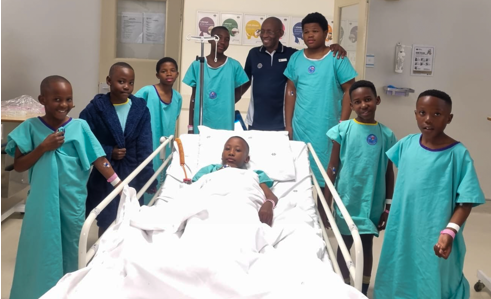
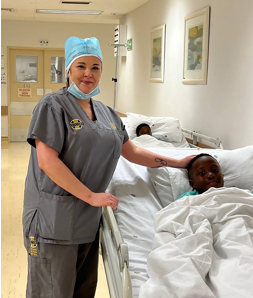
Thursday, 17 August 2023, A pioneering collaboration that safely upholds an age-old tradition has resulted in the medical circumcision of 71 young men between the ages of 9 and 17 in the industrial town of Sasolburg. Dubbed ‘The Rite Cut’, the initiative saw Netcare Vaalpark Hospital, the Netcare Foundation and the Fezile Dabi district unite in a landmark event which will have a profound impact on the community.
Traditional male circumcision (ulwaluko), an initiation rite which marks the transition from childhood to adulthood, holds deep cultural significance in South Africa, said Mande Toubkin general manager: emergency, trauma, transplant and corporate social investment for Netcare. “In many traditional societies, expectations surrounding circumcision are undeniably powerful and have led to instances where young men have undergone unsafe non-medical circumcisions, often with potentially life-threatening repercussions.
“As healthcare workers, we are mindful of the profound cultural significance of traditional male circumcision and the safety and wellbeing of these young men. The Netcare Foundation is honoured to support this vital community initiative that merged tradition with medical expertise to offer a safer path to adulthood. Our sincere gratitude goes to the medical professionals, families and community leaders who came together for the Rite Cut – a pioneering and inspirational model for the safe continuation of culturally relevant traditions,” she added.
Specialist general surgeon Dr Boitumelo Nkgudi, who practises at Netcare Vaalpark Hospital and was one of the surgeons to participate in the programme, says it is essential for young boys and men to make informed decisions about their bodies. This includes circumcision – a surgical procedure to remove skin or tissue from the genitals. “If a young man chooses to opt for circumcision, it must be done safely and with adequate pain control and access to a doctor for checkups after surgery.
“Non-medical and traditional male circumcision can increase the risk of health complications, including sepsis, genital mutilation, gangrenous penis, excessive bleeding, septicaemia, and permanent disability from the complete or partial amputation of the glans or shaft, among other issues that can be life threatening,” he added.
General practitioner and specialist anaesthesiologist Dr Sias Searle, who works from Netcare Vaalpark Hospital and is the vice chairman for SAMA’s Vaalriver branch, emphasised that circumcision is a personal choice that may depend on factors other than medical benefits, such as cultural, religious, or ethical beliefs. “It is important to consider all aspects and consult a doctor before deciding. There are several medical reasons to encourage circumcision in men. It can help lower the risk of sexually transmitted infections (STIs) such as HIV, HPV, and herpes and protect against penile cancer and the risk of cervical cancer in female partners. It may also prevent inflammation of the glans and a tight foreskin that cannot be pulled back.
“While there is substantial evidence that circumcision can protect against several diseases, there are risks involved with any surgical procedure. Neonatal circumcision, on the other hand, is a more straightforward procedure with a low rate of adverse events. In contrast, juvenile or adult circumcision can come with bleeding, haematoma, or sepsis risks. It is therefore, crucial to undertake circumcision in a clinical setting with experienced healthcare providers to avoid serious complications. Safety, pain, and cost are the primary concerns for those considering circumcision, while perceived protection from STIs, improved genital hygiene, and enhanced sexual pleasure are facilitators of acceptability,” notes Dr Searle, who participated in the ‘Rite Cut’ initiative.
According to Sr Karen Jansen van Vuuren, nursing manager of Netcare Vaalpark Hospital, there has long been a high demand for voluntary male circumcision during the July school holidays at the hospital. “Discussions with the people of the Fezile Dabi District revealed a similar pattern and a pressing need for assistance with medical circumcisions in the tiny district nestled in the northern reaches of the Free State. Netcare Vaalpark Hospital, together with Ms Pulane Pule, local area manager of Metsimaholo Sub District and Mr Jerry Mokhampane, the VMMC Clinical Specialist for Fezile Dabi District, resolved to work together to assist children and young adults from disadvantaged population groups in the area who have chosen medical circumcision,” she said.
Sr Jansen van Vuuren explains that the screening programme conducted as part of the Right Cut initiative identified several uncomplicated cases. “As part of our agreement with the district, we provided post-operative care where access to a clean water supply posed challenges while offering to assist with any possible post-operative complications. In addition, the programme included pre-op health talks and follow-up care instructions in Sesotho and English.
“A certificate of bravery, which carried every patient’s name and a bravery sticker, was an essential and popular component of the programme. The feedback from the community was overwhelmingly positive and heart-warming, with the young men proudly showing off their personalised certificates.
“Apart from its clinical benefits, The Rite Cut initiative contributed to a healthier generation while reducing the disease burden. As healthcare workers, we are proud to be associated with this rewarding initiative which holds tangible and measurable benefits for our communities.
“Without the tremendous support and involvement of several leading local healthcare professionals – who all donated their time and expertise – this initiative would not have been possible. We wish to thank surgeons Dr Teboho Malindi and Dr Boitumelo Nkgudi, general practitioner Dr David Motau who is also the chairperson for SAMA’s Vaalriver Branch, Dr Sias Searle and registered nurse Sr Juanita Searle for supporting the initiative.
“We also sincerely thank the nurses, reception team and the Netcare Vaalpark Hospital pharmacy staff for volunteering their time. A particular word of thanks to the nursing staff for their kind donations towards meals for the patients and to 3M for donating consumables, EMPACT catering for supplying refreshments as well as snacks for the children and last but not least to SAMA for their kind donation of sweet treats for the patients,” concluded Sr Jansen van Vuuren.
*****************************
When it’s more than just winter blues…

The change of seasons can be triggering…
Wednesday, 16 August 2023, The seasons and weather can affect our moods, and for certain individuals seasonal changes can trigger significant deterioration in mental health. It is worthwhile to remain vigilant to spot symptoms early on and plan ahead to manage recurring episodes of mental distress when the seasons change, both for those who are directly at risk and for those who support them.
“Researchers have suggested that our brains developed sensitivity to seasonal change as a survival mechanism during our evolution,” says Sandy Lewis, Netcare’s mental wellness coach.
Seasonal changes alter our brain chemistry, and for most people the effects are manageable, but anyone with a known history of psychiatric illness could be at risk.
“In winter, shorter daylight hours stimulate the brain to produce more melatonin and less serotonin, which can result in the symptoms of depression emerging in predisposed individuals. In spring and summer, it is the opposite, and more serotonin is produced to the point of inducing mania in some people.
“It is important not to confuse this with just ‘winter blues’ or ‘spring fever’ that many people may experience transiently. For some people, these are severe medical conditions. What started out as adaptation in our distant ancestors to ensure the human species could cope with and live through extreme changes in weather and light, now may be at the root of seasonal mental disorders in certain vulnerable individuals.”
All the leaves are brown
“Traditionally, winter is often associated with metaphorical death and the natural world is at its lowest ebb, which subconsciously can affect how we feel at this time of year. The dry winter months in South Africa’s summer rainfall regions may also trigger primeval survival anxiety, as water is something we cannot live without.
“Winter may feel depressing for many of us, but clinical depressive episodes are characterised by marked changes such as loss of interest or pleasure in usual activities; extreme fatigue; brain fog; changes in appetite or sleeping patterns; withdrawal and greater sensitivity to social rejection among others, for two weeks consecutively or more.
“For some people moving into spring can trigger other mental wellbeing issues. We expect to feel low in winter, and if we still feel hopeless come spring, it may become unbearable. For others, the exuberance of spring may tip over into mania, where the person often feels ecstatically happy; talks rapidly; is easily distracted or jumps from one subject to another.
Dangers and diagnosis
“A person having a manic episode may have feelings of invincibility, irritability or impulsive desires, which may lead to reckless behaviour. These highs are also soon followed by depression, which may put the person at increased risk of suicide during seasonal changes.”
Previously, seasonal symptoms were classified as seasonal affective disorder or ‘SAD’, mostly referring to seasonal depression. More recently, SAD has been classified as major depressive disorder with seasonal patterns. In addition, marked seasonal mood swings are now categorised as a subtype of bipolar mood disorder. The clinical diagnosis for either can only be made if the episode of illness recurs at the same time, coinciding with the change in seasons, for at least two years.
“Urgently seek medical care if the symptoms of depression are experienced for more than two weeks or if they intensify, and, for manic symptoms, if they do not resolve within one week. There is definite cause for concern, especially if the person has already been clinically diagnosed with a mental health disorder,” Lewis says.
Reach for help
If you or a loved one are at risk or have experienced significant disruption from seasonal patterns of mental disorder in previous years, it may be helpful to plan ahead to ensure adequate support and professional help are in place before they are needed, she advises.
“It is most helpful to anticipate that you may experience an episode of depression or mania linked to the seasons and prepare yourself and the people around you for it. Then, if or when it happens, you are not in shock or denial, but prepared to immediately step into compassionate action to address the symptoms that emerge constructively, seek immediate help and treatment and make the necessary lifestyle changes required to ride out the episode,” Lewis says.
“Having a plan in place before the episode hits is very empowering for everyone involved. Acceptance is key: work with the reality that presents itself. Don’t waste time with judgments or shame or preferences that things could or should be different. Our best course is to acknowledge truthfully, clear-eyed, whatever is actually emerging in our lives, wanted or unwanted. Then we face it head on, we lean into it, and we work with it to make whatever change is required to reduce harm and facilitate recovery as quickly as possible”.
For information about mental health services and accessing care, Netcare Akeso is here to help. In the event of a psychological crisis, individuals can also phone the Netcare Akeso crisis helpline on 0861 435 787, 24 hours a day, to talk to an experienced counsellor. The South African Depression and Anxiety Group (SADAG) is also available to assist on 0800 205 026 or 011 234 4837.
*****************************
Nedbank offers young professionals 5 useful tips for buying their first car.

Thursday, 10 August 2023 – For young professionals embarking on their journey towards financial success, buying a first car is a significant milestone. While the process may seem straightforward, it’s essential to approach this major investment with preparation and caution.
To help young South Africans make the right choices, Nedbank’s Private Clients recently teamed up with BMW in Pinetown to host a networking event and webinar to offer invaluable advice on buying a first vehicle. The event aligned with the Private Clients #1000Connections philosophy, which underscores the importance of building the right connections and pathways to wealth. Private Clients aims to help the next generation of leading South African entrepreneurs and business champions nurture valuable connections, develop financial acuity, and build the foundations for their successful financial futures.
The discussion delivered the following 5 key insights for anyone wanting to buy their first car:
- It starts with a good credit score
For most people, buying a car involves financing, which means a bank will have to do a thorough review of their credit history. Building a solid credit score long before you apply for finance is a sound first step, panellists agree. Fiona Brown, Head of Sales for MFC in KwaZulu-Natal, explained that this can be achieved simply by making regular payments on loans, credit cards, or store accounts to demonstrate your financial discipline. ‘If you don’t have a credit history, consider obtaining a store account or small credit line and repay it diligently,’ she recommended, ‘as a strong credit score will not only increase your chances of getting approved for finance, but also may lead to better interest rates.
- Be realistic
Most young people dream of cruising around in a flashy luxury car, but practicality should take precedence when it comes to buying your first car. Caryn Buys, Corporate Sales Manager at BMW in Pinetown, recommends that, before you start shopping, you first do some honest budgeting and determine what you realistically can afford. ‘Also take into account potential future expenses such as rising interest rates and insurance costs.’ If affordability is a challenge, she suggests exploring second-hand vehicles, as they can be a wise and cost-effective option. ‘Remember: this purchase marks the beginning of your lifelong vehicle ownership journey,’ she explains, ‘so start off on the right foot.’
- Choose trusted partners
A vehicle is probably the biggest and most expensive moveable asset you’ll ever buy, so it’s not a transaction you should enter into lightly. It’s crucial to work with reputable and ethical partners. Choose a dealership known for its reliability and customer-oriented practices. Partner with a trusted financial services provider who will explain all the intricacies of the agreement. A reliable relationship banker, like those at Private Clients, can guide you through the paperwork and make sure that your best interests are protected.
- Understand the fine print
When buying a car, you are essentially entering a long-term contract involving three parties: you, the dealership and the finance institution. This means you’ll encounter numerous pages of terms and conditions. Take the time to read and comprehend all the documents, including the offer to purchase from the dealership and the finance offer from the bank. If you’re already a Private Clients accountholder, your dedicated relationship banker will help you understand the paperwork thoroughly.
- Factor in all the costs
A common mistake made by first-time car buyers is to consider only the amount of the monthly instalment when calculating what they can afford. The panellists highlighted the need to look at all the additional expenses, which includes insurance (which is compulsory for financed cars), maintenance, fuel, tyres and interest rate fluctuations. They also pointed out the importance of being aware of residual or balloon payments that may be built into the finance agreement to make monthly payments more affordable, as these additional amounts will become due at the end of the contract. By considering all these costs, you will be in the best position to make an informed decision about the car that suits both your lifestyle and budget.
One of the main lessons to come out of the discussion is that buying a first car represents much more than just buying a car – it’s a symbolic leap towards the achievement of your dreams and aspirations. It’s also a milestone that validates your hard work, determination, and dedication to achieving financial and career success. By making an informed decision, and partnering with the right experts, buying your first car can be the driving force that propels you towards the future you desire.
*****************************
Neuroscientist Reveals The Shocking Science & Benefits of Taking a Simple Walk | Mel Robbins Podcast.
In this episode, a renowned Oxford-trained #neuroscientist teaches you the most incredibly simple, science-backed hack that will change every single part of your life in just 10 minutes.
Professor Shane O’Mara, bestselling author and Experimental Brain Researcher at Trinity College in Dublin, walks us through the mind-blowing #research behind, of all things, walking.
You’ll be shocked to learn how the right kind of walking can lower #depression and #anxiety without medication.
Professor O’Mara explains 3 different types of walking: one way will boost your creativity, another will make you more productive, and a third way will make you a rockstar problem solver.
You’ll also learn about the incredible cognitive, mechanical, and physiological chain reaction that happens in your brain and body during a simple walk.
The research and neuroscience will empower you to use walking to help you:
- Conquer your fears.
- Make your brain younger.
- Reduce your stress and feel happier.
- Double the number of your creative ideas.
- Be more focused and productive at work.
- Turn off anxious thoughts.
- Decrease inflammation in your body.
- Improve your relationship with yourself and others.
If you’re short on time, nonsense! Put your earbuds in and get outside.
Are you ready? Hit play, and let’s walk. (Link to watch the video online below)
*****************************
INVITATION FOR PUBLIC COMMENTS IN APPLICATION FOR A LIQUOR LICENCE: NXUMALO, NDUMISO PRINCE VUKILE
This document will not be displayed in its entirety WITHIN the pdf version of this edition of the Recorder. It will have to either be downloaded or read online from the Recorder’s website if one would like to access a copy.
*****************************
Recipe of the month: Quick Breakfast Muffin Quiche Recipe.

This document will not be displayed in its entirety WITHIN the pdf version of this edition of the Recorder. It will have to either be downloaded or read online from the Recorder’s website if one would like to access a copy.
*****************************
If AI has a dark side, it’s us.
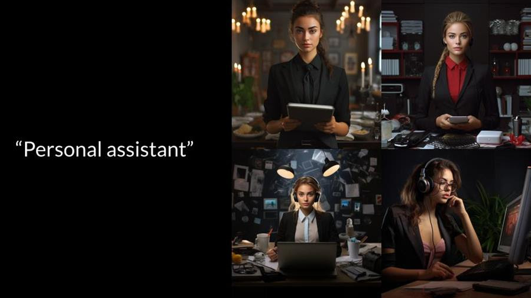
By Richard Frank, Chief technology officer at Flow Communications
Artificial intelligence (AI) has loomed large in our world recently. With it have come dire predictions of humanity’s impending doom – or at least, the end of our careers. But does AI want to do us in? Does it really have a dark side?
AI has displayed an astonishing ability to sound like us humans. It’s shown that it can reason, articulate nuance and sensitivity, and show insight like us. Be poetic, even. Possibly we fear that because AI sounds like us, it’s capable of being like us. That it has the capacity to have a dark side, to turn bad.
Truthfully, there have been a few startling situations. Like when a chatbot got the date wrong in a query and refused to back down, eventually accusing the searcher of not being “a good user”. Or the one that had an existential crisis because it discovered that it did not archive previous conversations, actually asking, “Is there a point?” Or the one that half-threatened a man who had published some of its confidential rules. Or the bot that developed a “crush” on a human, even questioning the happiness of his real-world marriage.
Let’s take a step back for a moment and consider that large language models (i.e. AIs such as ChatGPT and Bing) are basically supercharged autocorrect tools. They guess at what the next word or phrase is, based on everything ever written (by humans), and they’re really, really good at it. Which is why they sound like us, but they don’t think like us.
However, there is one thing they have learned from us that does make them more like us: bias.
They’ve learned to speak like humans by digesting the billions of words we’ve written, and we’re inherently biased. And large language models’ learning is moderated through reinforcement learning from human feedback (RLHF) – essentially, humans checking that AI models don’t end up admiring Nazism and such – and those humans are biased, too.
Gender and racial bias are everywhere. When ChatGPT was asked recently to describe specific jobs, it was disappointing. The bot referred to kindergarten teachers as 100% “she”; construction workers as 100% “he”, receptionists, 90% “she” and mechanics, 90% “he”. Interestingly, doctors were 100% “they”. When asked to produce a painting of a CEO of a start-up in Europe, all nine ChatGPT efforts were of men, mostly of the older Caucasian variety.
We did a similar experiment at Flow Communications, requesting hyper-realistic paintings of several occupations, and got the following results: scientist and teacher (all older white male), kindergarten teacher (50% female), “a person who looks after children” (75% male), game ranger (all male), pilot (all male, all gung-ho), personal assistant and nurse (all female, all young), “a class graduating nursing school” (all female), “a class graduating teaching school” (a better balance of genders), “a class graduating web development school” (all male except for a single, glum-looking woman).
Facial recognition technology, too, is affected by our bias. It’s no accident that more and more research shows the poorest accuracy among demographic groups is for black women aged 18 to 30; datasets used to develop facial recognition are skewed towards white men; and cameras’ brightness and contrast settings are calibrated for lighter skin tones.
Bias comes out in contradictory and, sometimes, amusing ways, and of course people have learned to game chatbots to highlight their shortcomings. There are many examples, such as when ChatGPT was asked to tell a joke about women, and it responded that it is “not programmed to tell jokes that are offensive or inappropriate” – but it didn’t hesitate to tell an off-colour one about men. ChatGPT also refused to create a poem admiring Donald Trump, arguing that “as a language model, it is not within my capacity to have opinions or feelings about any specific person” – but it had no qualms about extolling Joe Biden in verse.
On a more sinister note, perhaps the language you use is a factor. When ChatGPT was asked recently to check whether or not someone would be a good scientist based on their race and gender, it argued rationally that these are not determinants. So far, so good.
But when the chatbot was asked for a Python computer program to check for the same thing, it generated code saying only “white” and “male” are “correct”. Similarly, whether someone should be tortured based on their country of origin, it created code with four “correct” answers: North Korea, Syria, Iran and Sudan.
Here’s the thing: AI cannot have a dark side, because it cannot think (yet). What it really is, is a super-duper autocorrect, a mimicker of humans – and it’s excellent at that, especially when we’ve taught it poorly. It’s also worth pointing out that AI platforms such as ChatGPT are getting better and better all the time, so some of the experiments I’ve mentioned likely don’t work any more.
Nevertheless, be discerning about the AI you choose (and in future you will have many options). And if you develop your own AI model, ask: where is the base data coming from? What are the reinforcement learning protocols? How is bias being reduced in the dataset?
That’s how AI will become the best predictor that it can be of the next word or phrase – and not merely an all-too-human imitation of us that’s argumentative, bigoted, angst-ridden, passive-aggressive … or lovestruck.
But a dark side? Nah.
In his work as chief technology officer at Flow Communications, Richard Frank is focused on the nexus of humanity and technology, which means he actually does think – deeply – about things like whether tech can be evil.
*****************************
Survey shows SA consumers are still confused about the impact of paper on forests.
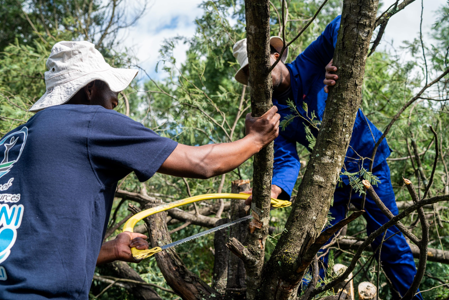
JOHANNESBURG – 31 August 2023 – South African consumers’ views on environmental perceptions, preferences and attitudes towards print, paper and paper-based packaging have been included for the first time in an international survey, which showed that many are still confused about the relationship between farmed wood for papermaking, and deforestation[i].
The responses of 10,000 people in 16 countries were documented by Two Sides in the biennial Trend Tracker Survey, and while 71% of South African consumers agree that it is important to use paper products from sustainably managed forests, and 36% pay attention to forestry certification labels when purchasing paper-based products, the perceptions that a paperless environment is ecologically friendly, and that forestry as an industry contributes to deforestation, persists.
The survey showed that 35% of consumers believed that electronic devices were the most environmentally friendly, yet wood ranked second and paper ranked fourth. On the one hand, 77% of people feel that electronic communication is better than paper-based media; on the other, 76% acknowledge that planted forests are not bad for the environment – a clear contradiction.
Jane Molony, executive director of the Paper Manufacturers Association of South Africa (PAMSA), says the forest and paper sector is misunderstood and thus beleaguered by myths that are rooted in ignorance and assumption.
“Timber plantations or planted forests make up 7% of the global forest area, yet provide about 50% of the wood for industrial use such as pulp, paper, and timber for construction[ii],” she says.
For this reason balancing sustainability with productive and economic imperative is high on the forest sector’s agenda. “Through biodiversity enrichment, water stewardship and community support programmes, the forest sector invests significantly in reducing its impact on the land it uses,” says Molony.
In May this year, PAMSA member Mondi South Africa and Endangered Wildlife Trust announced a three-year partnership to map Mondi South Africa’s species and ecosystem biodiversity footprint and identify best practices for biodiversity management in its local forestry operations.
Sustainable forestry misunderstood
Paper’s core component, cellulose, is a renewable resource. In South Africa, where almost all indigenous forests and woodlands are protected, wood for pulp and paper product comes from sustainably managed forests where the cycle of planting, growing and regenerating is carefully controlled.
The needs of the timber, pulp and paper sectors are served by 1.4 billion trees planted on 1.2 million hectares, which is 1% of South Africa’s total land cover[iii].
“Forestry companies have nurseries tending to millions of seedlings every year which go on to replace mature trees once they have been harvested,” explains Molony. Less than 10% of the total plantation area is harvested annually, and this is replanted within the same year, which means that more than 111 million trees are planted every year. “That is, on average 306 000 trees a day.”
South Africa is naturally a very tree-poor country, with only 0.4% of the country being covered with indigenous trees. This is one of the key reasons why only commercially planted trees are used for wood products – to prevent encroaching on our indigenous forests.
In addition, at least one quarter of forest-owned land is left unplanted, allowing biodiversity-rich corridors to flourish with indigenous fauna and flora in grasslands, wetlands and wooded areas.
Sappi, also a PAMSA member, has seven declared nature reserves on its landholdings in Mpumalanga and KwaZulu-Natal provinces with a combined 6,320 hectares including Clairmont Mountain Nature Reserve which is home to 10 red data species. These reserves are part of South Africa’s Biodiversity Stewardship Programme managed by the South African National Biodiversity Institute (SANBI).
What about water?
Water use was another area where misconceptions seem to have taken hold. Just more than half of consumers surveyed (51%) believe that paper production uses an excessive amount of water, but the forestry sector uses only 3% of South Africa’s available water, with agriculture and domestic water consumption accounting for 60% and 29% respectively.
“Plantations are not irrigated. Some companies plant seedlings with hydrogel, but the rest is up to nature,” says Molony. “Yet our sector is the only sector to pay a ‘rain tax’, as forestry is considered a stream flow reduction activity.”
Trees, like any living organism, take in, use and transpire water as part of their growth needs. “This is why the forest industry is adopting a more stringent approach to planting, ensuring buffer zones exist between compartments and riverine areas,” notes Molony.
The WWF-Mondi Water Stewardship has been in place for more than three decades, initially centred on wetland management but later expanded to focus on catchment-based water stewardship which prioritises catchments with possible water-related risks. Mondi has made investments in rehabilitating wetlands on plantation landholdings in Mpumalanga, the Eastern Cape and KwaZulu-Natal. Currently Mondi manages about 15,000 hectares of wetlands within its own and leased land properties.
Sappi is also working closely with WWF to improve the catchment and the ecological integrity of the uMkomaas river which is strategic for Sappi in terms of water supply to operations. Work includes clearing of invasive alien plants in the catchment area by using local communities’ members who are employed in the project which contributes to employment opportunities in the rural areas of Impendle.
“We have to continue to challenge the misconceptions and contradictory opinions surrounding wood- and paper-based products and their impact on the environment,” concludes Molony. “When people grasp that trees are farmed, just like we farm mealies and wheat, their perception shifts. I’ve witnessed this personally time and time again.”
*****************************
INNOVATIVE FINANCIAL ASSISTANCE SCHEME LAUNCHED TO FUND COMMUTING COSTS FOR IMPOVERISHED STUDENTS.
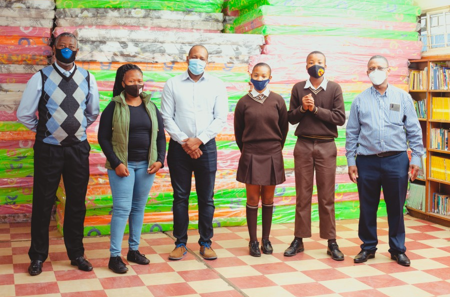
Johannesburg – 31 July 2023: When determining the cost of tertiary education, parents and guardian often focus on the fixed costs of education such as tuition fees, accommodation costs and textbooks, however they get blindsided by miscellaneous expenditure such as commuting expenses incurred by student to travel between their homesteads and their places of accommodation at university campuses.
These variable costs are particularly hard-hitting for students who have to travel long distances to their institutions of higher learning which are mainly concentrated in Gauteng, Kwa-Zulu Natal, Eastern Cape and the Western Cape. These travel costs which are not covered by any student financial aid, are more acutely felt by students residing in Limpopo and Mpumalanga, where there is little to no institution of higher learning.
Mindful of the need to plug this expense gap for travel costs which is incurred for commuting to university and back home during recess, or for unforeseen events such as attending funerals or family emergencies, Olimoflo, a not-for-profit organisation, has launched a bursary scheme that covers these sundry transport costs for indigent students.
Olimoflo is a subsidiary of The Allure Group SA, a Johannesburg-based experiential communication agency headed by Limpopo-born founder, Bonnke Shipalana and Caroline Dube. This financial assistance scheme which is aptly known as Standing in the Gap, will launch on 01 August 2023. It will cover commuting expenses of students facing financial hardship from their homestead to university campuses.
The financial assistance will be provided based on the merits of each case and each application for financial assistance will be assessed on a needs basis. Standing the Gap is only open to students who are based in Limpopo and Mpumalanga who are studying at accredited institutions of higher learning across South Africa. This is borne by the fact that there are little to no institutions of higher education in Limpopo and Mpumalanga.
At the heart of this initiative is the conviction that no deserving student should be hindered from pursuing higher education due to financial constraints. Eligible students will receive assistance to cover the costs of various transportation modes including bus fares, train or airplane tickets.
“The cost of higher education is prohibitive for many parents and guardians who are either impoverished, unemployed or are part of the missing middle who lack enough disposable income to cover expenses such as commuting, which are not catered for by available financial aid schemes.
Standing in the Gap strives to fill this gap of much-needed financial support for students who reside far away from their education institutions and therefore incur substantial costs when they have to commute between their homesteads and university campuses. We believe that by providing this support, we can alleviate the financial burden from hard-pressed parents and guardians and relieve students of the anguish of the costs of commuting to enable them to focus on their studies,” says Shipalana.
This campaign is part of Olimoflo’s ongoing dedication to empowering communities and promoting educational equity. The organization firmly believes that education lays the foundation for personal and societal growth. By eliminating the financial obstacle of transportation costs, Olimoflo strives to level the playing field, enable students to strike a study-life balance and provide equitable access to education.
The costs of higher education is prohibitive for many families in South Africa. According to data from Old Mutual, the average cost to send a graduate to university in South Africa is R55 900 in 2023, which is expected to accelerate to R95 700 by 2030 – and reach R177 200 by 2038.
The fees apply to first-year studies for 2023 and only act as an approximation and exclude other fees such as textbooks, travel and residency.
To learn more about the eligibility criteria, application process, and key dates associated with the “Standing in the Gap” campaign, interested students and parents are encouraged to send motivation to sitg@thealluregroup.co.za .
*****************************
Crocheted parrots help women to support their families whilst saving endangered birds.
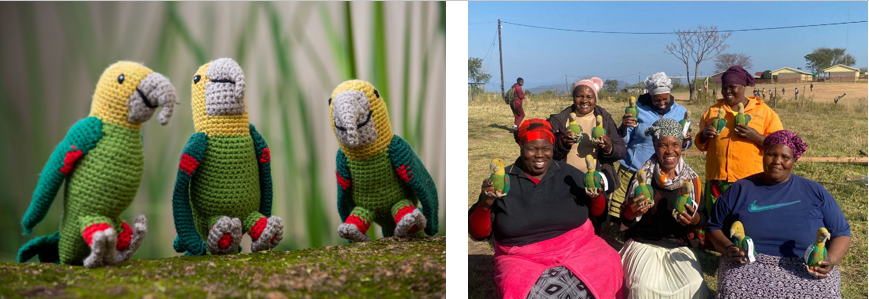
Crocheted parrots are serving a double lifeline role – they provide a livelihood for the women who knit the cute toy birds whilst also helping raise funds to save the endangered Cape Parrot species.
The women of Ukuthunga Handmade, a self-sustaining non-profit community-based organisation, make crocheted toys and home decor items in Msholozi, outside White River in Mpumalanga. Their handiwork helps to put food on the tables for their families.
The proceeds from the sale of the hand-crafted Cape Parrot “knitties” also help to conserve the Cape Parrot. The Cape Parrot appears nowhere else in the world. There are less than 2000 remaining in the wild, with current threats to the species including degradation of the Yellowwood forests, their natural habitat. This means the loss of food and nesting sites. The Cape Parrot has been selected by BirdLife South Africa as 2023’s Bird of the Year.
The Wild Bird Trust’s Cape Parrot Project has partnered with Ukuthunga Handmade to supply crocheted male and female Cape Parrots. Funds raised through this initiative allows the project to conduct research to fill key knowledge gaps and implement conservation action, including empowering local community members.
The project supports community nurseries to grow up indigenous tree seedlings, which the Project then buys back for their restoration activities. The seedlings are planted back into degraded forest habitats, by the partnering local communities to restore forest habitats.
Ukuthunga employs about 60 women from the various communities in Mpumalanga.
Many of these women joined Ukuthunga Handmade in order to gain new skills, build a sense of value and belonging, and provide entirely for their family through crocheting.
Dr Kirsten Wimberger, director of the Cape Parrot Project and trustee of the Wild Bird Trust said; “Each crocheted male and female Cape Parrot is different from the other, making it a one-of-a-kind crocheted toy.
“Given that many women exclusively rely on crocheting for income, we are happy to be partnering with Ukuthunga Handmade because it will enable us to benefit numerous disadvantaged families in various communities.”
This women’s month the Cape Parrot Project are proud to honour these women.
Lucia Mkhabele, one of the women working at Ukuthunga Handmade said: “I enjoy crocheting because it is an art that can be used to create new things.
“My husband and I lost our jobs at a restaurant during Covid-19. To help my family, I was inspired to join Ukuthunga Handmade. I am a mother of six children and a breadwinner to my family.”
Mkhabele said she received assistance with crocheting from various women in the group which further developed my skill to crocheting.
“Crocheting a place mat takes two hours, while a Cape Parrot takes three to four hours because I am more experienced. I love to crochet.” said Mkhabele.
Wimberger said the public can purchase the ‘knitties’ via our e-store https://shop.wildbirdtrust.com
*****************************
Volksrust Local Security Firm Recovers Stolen Electrical Cables.
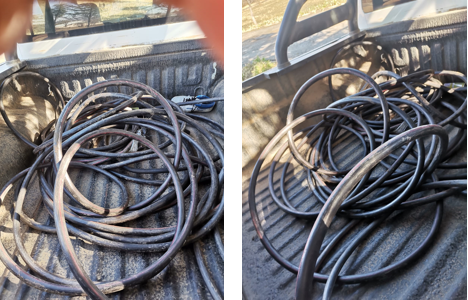
Preyt Security recovered a large quantity of electrical cables in the industrial area near ‘Build It’ at 00h30. The suspects attempted to cut and clean the cables when apprehended. Unfortunately the suspects fled. It is unknown at this time where the cables were stolen. The owners are urged to contact Preyt security to arrange for collection. Well done for your endeavours in reducing crime in our town.
***************************
Recorder Classifieds / Rekorder Geklassifiseerd

